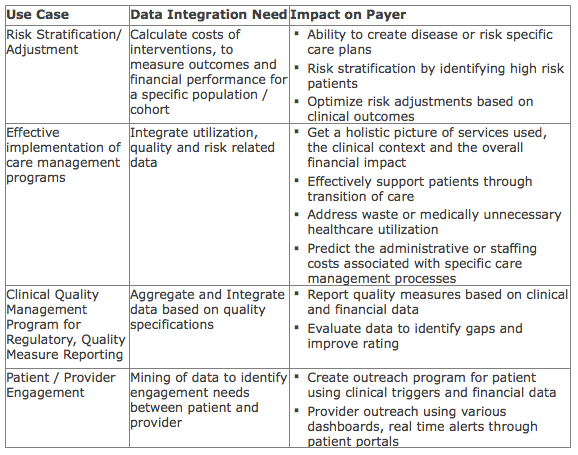Payers’ involvement in patient care, and their access to clinical data, has remained limited. They have traditionally relied on claims data, and the limited clinical data available on claims forms, to build care management applications as well as manage cost reduction programs.
For example, member outreach programs for a high-risk patient with a chronic condition are based on incoming claims data. With the claims processing cycle, it may take a month or more for a hospital visit to be reported. Member information provided by the hospital often does not contain critical clinical details like historical medical records and vital signs that would help the payer identify high-risk patients or optimize its outreach strategy.
The Case for Clinical & Financial Data Integration
Payers are quickly realizing that getting access to clinical data and effectively leveraging it is not just a necessity, but will soon become the basis for incentive payouts.
As of recent, quality reporting programs like Healthcare Effectiveness Data and Information Set and Medicare Advantage star rating system have put some pressure on payers to adopt more patient-centric approaches for member management. Many of these approaches involve greater access and use of clinical data, reducing adverse reactions and cutting down on repeated clinical procedures like laboratory tests and scans.
The critical need for payers to gain greater access to clinical data has also been corroborated by recent surveys, which estimate that nearly two-thirds of healthcare executives believe there would be significant advantages. Especially in areas like Potentially Avoidable Complications (PAC), payers benefit greatly from aggregating historical clinical data and evidence of a particular complication to define risk-based patient cohorts for disease management and care coordination programs. These cohorts can help optimize PAC cost drivers and manage cost variations in clinical episodes, thus getting better control of pricing and claims.
The Clinical Data Challenge for Payers
For traditional payers, even where clinical information can be made accessible, integrating this data with their own systems and deriving actionable intelligence poses significant challenges. Payer-provider collaboration faces a number limitations:
- Incompatible Systems. While clinical data is available from a multitude of provider systems, payers don’t typically own systems that have the ability to aggregate and leverage the data. Currently, their workflows are nowhere near ready to access and consume this information, let alone integrate it with their own data sources.
- Siloed, Manual, Incongruent Aggregation of Clinical Data. A payer’s IT infrastructure can have a vast proliferation of diverse applications, running on multiple technologies, at any given time. They include complex transactional systems and data models used for various analytics and risk management operations. With their current technology ecosystem, access to clinical data is severely restricted by a manual conversion processes. It is also necessary for the technology to accommodate various, incongruent data sources like national registries, imaging systems, genomics, telemetry, billing data, devices, etc.
- Clinical Data Quality and Terminology Gaps. While payer systems have been stringent in following industry standards, provider systems still struggle with compatibility. Many challenges exist due to the presence of numerous electronic transaction standards and clinical terminologies.
Clinical Data Convergence: Overcoming Integration Challenges
To overcome some of these challenges, organizations need to follow a structured approach to integration and data sharing. This would involve:
-
Defining a Roadmap. The key to effective integration is to adopt a phase-wise approach, identify high impact use cases and prioritize applications in terms of criticality to the identified use cases.

- Building a Mechanism for Seamless Sharing of Clinical Data. Organizations should focus their energies on building an efficient Master Patient Index that will act as the primary key for a customer data mart. Proper integration usually requires adapters that take in data from disparate provider systems, such as EMRs, lab systems, pharmacy systems and other clinical applications. Complete data integration systems would consist of turnkey tools that extract, aggregate and normalize data from various clinical and financial systems, for use in one cohesive application.
Going from Clinical Data Convergence to Actionable Insights
Beyond the technology challenges, organizations also need to focus on building effective mechanisms and processes to derive actionable insights from the integrated data.
-
Defining the Right Use Cases. The success of integration initiatives rests largely on the ability to address key challenges. It is necessary for decision makers to define use cases and business requirements clearly.

- Making the Aggregated Data Meaningful to Payer Operations. Aggregated data will help payers view a patient’s entire medical profile with insights from across the continuum of care, including primary and specialty care, hospital, lab, pharmacy and even state-based immunization systems.
To achieve this level of actionable intelligence, payers need to leverage an integrated analytics platform enabling them to define cohorts, build a reporting ecosystem and get a drilled down view of member performance. The resulting longitudinal records can help payer organizations build powerful analytics for risk stratification, care management and population health management.
Eventually, the effectiveness of payer-provider collaboration and the resulting intelligence relies largely on the technology team’s commitment to following a structured, logical approach and organization-wide initiatives to ensure optimal use of data provided. If utilized effectively, clinical data exchange can have significant advantages for organizations across the care continuum.

















